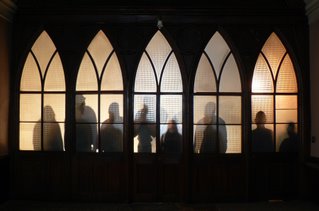
The New York Times has recently done a number of interesting articles about historic preservation and heritage tourism, including:
Homes Sell, and History Goes Private (Tracy Rozhon) which describes Colonial Williamsburg Foundation's recent decision to put the historic house, Carter's Grove, up for sale (photo above from Colonial Williamsburg's site). The article has provoked much thoughtful discussion about the diverse efforts of historic house and living history museums to stay open and remain relevant in the face of declining visitation rates and increasing competition for education and entertainment dollars. More information follows this list of articles.
Fantastic animated graphic images showing the planned restoration of Central Park's Bethesda Terrace to the original designs of Calvert Vaux and Frederick Law Olmsted.
Brick Houses, Winding Paths and Unexpected Sharp Elbows (Jeff Vandam), describing recent efforts by local preservationists and New York City's Landmark Preservation Commission to designate Sunnyside Gardens, a 16-block, cooperative garden community in western Queens, as a historic district.
Reclaiming the Revolution and the related articles The Fight for Independence in a Strategic Region and Timeline: Paths of War, From Long Island to Princeton (all by Terry Golway). These articles describe American Revolution sites in New Jersey and Congress' recent passage of legislation designating hundreds of the state's Revolutionary War sites as part of a new entity called the Crossroads of American Revolution National Heritage Area. A slide show of sites and re-enactors is also included.
Once a Hub of Strife, Boston Woos Black Tourists (Joshua Kurlantzick), describing a historic tour of Roxbury by trolley, and some of Boston's efforts to change its image among black Americans.
Using Redevelopment to Tell a Story (Lisa Chamberlain), describing Durham, North Carolina and private developers' recent efforts to turn a painful past into opportunity, using history as a teaching experience while also rebuilding a once-vibrant commercial district. Working in partnership, two developers will redevelop 20 buildings, or 600,000 square feet, as well as a vacant lot that was once the site of a Woolworth's where lunch counter sit-ins took place, attracting the support of the Rev. Dr. Martin Luther King Jr. in 1960. The city has been organizing business owners and volunteers to build a "museum without walls" and is completing infrastructure improvements.
Mothering Brooklyn (Susan Dominus), a eulogy for long-time Brooklyn preservationist Evelyn Ortner describing Evelyn and Everett Ortner's efforts to revitalize Brooklyn, beginning in the mid-1960s.
To read more about the protected sale of Carter's Grove (meaning that "restrictions would be implemented for the long-term protection of the site's historic, architectural, visual, archeological, and environmental resources"), see Colonial Williamsburg Foundation to Proceed with Protected Sale of Carter's Grove, which includes a fact sheet about the protected sale of the Carter's Grove site and statements from the National Trust for Historic Preservation and the Association for the Preservation of Virginia Antinquities. In establishing sales restrictions, Colonial Williamsburg hopes to establish standards that will serve as a model for the historic preservation community.
Readers may also be interested in a new book by Donna Ann Harris, New Solutions for House Museums: Ensuring the Long-Term Preservation of America's Historic Houses. A blurb on the back cover of the book notes that a "generational shift is occurring at historic house museums as board members and volunteers retire and few young people are taking their place. These landmarks are also plagued by serious deferred maintenance and few have any endowment whatsoever. What will happen to these sites in the next ten years? Harris provides a decision-making methodology as well as a dozen case studies of house museums that have made a successful transition to a new owner or user to assure the continuing preservation of the landmark for generations to come."


